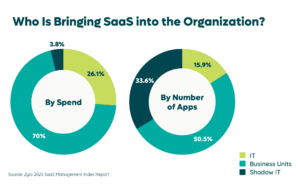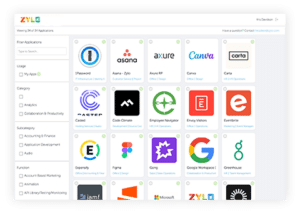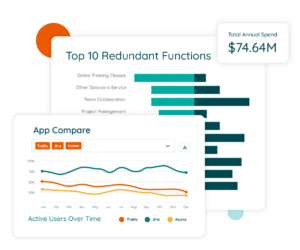Table of Contents
On average, organizations spend nearly $49M on SaaS each year, but only utilize 47% of their provisioned licenses, according to Zylo research. The money left ($21M annually) on the table boils down to poor application portfolio management (APM).
Why is application portfolio management important? Without a robust APM strategy — which simply refers to the proactive approach organizations use to effectively manage their software application assets — organizations risk data breaches, data loss, unplanned expenses, and more.
But APM’s value extends beyond mitigating risks. Effective application portfolio management brings numerous benefits to organizations, including equipping employees with the right tools, streamlining portfolios, maximizing investments, and reducing costs. Learn more about the benefits of application portfolio management.
4 Benefits of Application Portfolio Management
#1 Empower Employees with the Right Tools
Self-service software has become the norm. When an employee needs a tool to get the job done, they simply buy it with a corporate credit card. Zylo research shows 34% of all applications today originate from employee-led purchases.
 But this decentralization puts companies at risk, as unvetted software flows through organizations at an alarming rate. Effective APM mitigates these risks, while still providing employees with the tools they need to be productive, through a model we call Freedom within a Framework.
But this decentralization puts companies at risk, as unvetted software flows through organizations at an alarming rate. Effective APM mitigates these risks, while still providing employees with the tools they need to be productive, through a model we call Freedom within a Framework.
By inventorying assets across an organization’s entire SaaS stack, IT managers ensure applications align with business needs. Businesses can then add those tools to a pre-vetted and approved app catalog. Empower employees to self-select the tools they need to be the most productive and implement a process for them to request anything outside of the catalog.

#2 Streamline Your SaaS Portfolio
APM helps streamline SaaS stacks, reducing duplicate or redundant apps with functional overlaps. Not only does this result in cost savings, but a streamlined SaaS portfolio offers better collaboration and productivity across the business. For example, reducing project management tools from 15 to five leads to more employees operating within the same tool, cutting down on Slacks, emails, and shared Google Sheets.
 When streamlining your SaaS portfolio, dig into utilization metrics to learn whether employees actually use and value your owned apps. Re-evaluate business needs for any app receiving a utilization rate lower than 90%, whether by reducing the number of licenses or eliminating the tool.
When streamlining your SaaS portfolio, dig into utilization metrics to learn whether employees actually use and value your owned apps. Re-evaluate business needs for any app receiving a utilization rate lower than 90%, whether by reducing the number of licenses or eliminating the tool.
While you may find these metrics within the apps themselves, a SaaS Management Platform that directly integrates into mission-critical applications, like your CRM, web conferencing, product management applications, and office suites, helps accurately measure application utilization across the entire software portfolio.
Evolving Your SaaS Governance Framework for the Digital Workplace
Learn More#3 Maximize SaaS Investments
Rationalizing an app catalog provides multiple opportunities to maximize investments. For example, you may find multi-channel spend, meaning employees are expensing a tool even though your company has an official agreement with the vendor. Maximize your investment by consolidating those single licenses into the company plan, then negotiating a better volume discount with the vendor.
Rightsize licenses by finding any unused seats within an app. Deprovision employees no longer using the tool, then reassign their licenses. Or, eliminate the excess licenses or unutilized tools.
A SaaS Management Platform helps companies dig deeper into utilization data to find these opportunities to maximize SaaS investments. At Zylo, customers who use the platform and services together see an average 6x ROI.
“SaaS management is a must-have,” says Gordon Atkin, VP of Technology and Business at Salsify. “SaaS is the number two spend, especially at SaaS companies. For more traditional legacy or on-premise companies, it’s going to be a cost that continues to creep up, and traditional software asset-tracking solutions aren’t going to help you manage that.”
#4 Reduce Costs
Perhaps going hand-in-hand with maximizing investments, SaaS APM helps reduce costs across organizations. An effective APM finds and eliminates underutilized and unused applications on an ongoing basis, which proves critical when the average organization sees eight new apps enter its organization each month.
Through app rationalization and consolidation, Genesys experienced more than 12% in SaaS cost reduction. Within its first six months with Zylo, the business consolidated licenses for more than 10 SaaS apps.
Genesys Leverages SaaS Management to Further Digital Transformation
See how the leader in cloud customer experience and contact center solutions reinforces software asset management and enterprise architecture with Zylo.
Coupa lowered SaaS cost per user by 9-30% and reduced the number of apps within their portfolio from 600 to 400, by utilizing Zylo’s SMP. Their SaaS discovery fueled collaboration across the organization and resulted in a new governance framework for SaaS Management.
“SaaS management is not just about reducing spend,” says Coupa CIO Eric Tan. “It’s about ensuring governance and creating efficiency.”
Want to see what the benefits of application portfolio management can do for your organization?
- Discover four common APM use cases
- Learn how to get started with APM for SaaS
- Follow these 3 application portfolio management best practices

